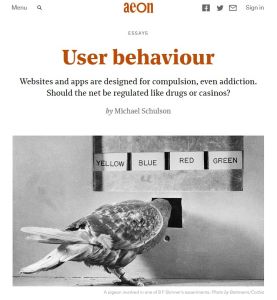Join getAbstract to access the summary!

Join getAbstract to access the summary!
Michael Schulson
User Behaviour
Aeon, 2015
What's inside?
Businesses explicitly design their websites to be addictive. Would regulation help users regain some control?
Recommendation
When a person begins to show signs of Internet addiction, is it only a lack of self-control which is to blame? Freelance science, religion, technology and ethics writer Michael Schulson explains how and why designers craft modern websites to be addictive and explores the ethical implications of companies that profit from “hooking” you in this manner. Schulson also posits practical forms of regulation that might discourage user exploitation. getAbstract recommends this article to those interested in the behavioral sciences and regulation and folks who suspect they’re spending a bit too much time online.
Summary
About the Author
Michael Schulson is a freelance writer and an associate editor for Religion Dispatches.


















Comment on this summary